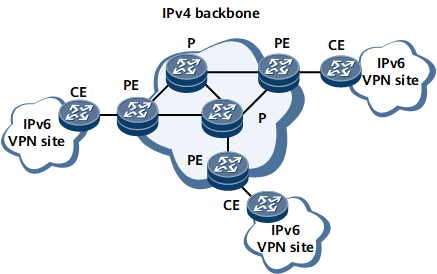Overview of BGP/MPLS IPv6 VPN
This section describes similarities and differences between BGP/MPLS IPv6 VPN and BGP/MPLS IPv4 VPN.
As an enhanced version of IPv4, IPv6 is a next-generation Internet protocol. IPv6 provides the enhanced address space, configuration, maintenance, and security functions, and supports more access users and devices on the Internet than IPv4.
A VPN is a virtual private communication network built over shared links or public networks, for example, the Internet. Users located in different areas can exchange data over shared links or public networks.
On an IPv6 VPN, CEs send IPv6 packets to PEs, whereas on an IPv4 VPN, CEs send IPv4 packets to PEs.
Solution using carriers' IPv4 backbone networks to carry IPv6 VPN services, which is also called the IPv6 VPN provider edge (6VPE) solution
Solution using carriers' IPv6 backbone networks to carry IPv6 VPN services
Currently, only the 6VPE solution is supported. In this situation, PEs must support IPv4/IPv6 dual-stack because the backbone network runs IPv4 and customer sites use IPv6 address families, as shown in Figure 1. Any network protocol that supports IPv6 services can be used to set up connections between CEs and PEs. PEs use IPv6 on interfaces connected to customer sites and IPv4 on interfaces connected to the core network.

Different from 6VPE that is an IPv6 VPN technology, IPv6 provider edge (6PE) is a solution that uses MPLS tunneling technology to provide connectivity services for separate IPv6 networks in different areas over an existing IPv4 network. 6PE implements the IPv4/IPv6 dual-stack on the PEs of Internet service providers (ISPs), and uses Multiprotocol Extensions for BGP (MP-BGP) to assign the PEs labels, which identify IPv6 routes. In this way, the separate IPv6 networks can communicate with one another through IPv4 tunnels between the PEs. For details about 6VPE configuration, see VPN > BGP/MPLS IPv6 VPN Configuration > Configuring 6VPE in the configuration guide. For details about public network 6VPE configuration, see Configuration Guide > IP Route Configuration > BGP4+ Configuration > Configuring BGP4+ 6PE.
IPv6 VPN uses MP-BGP to advertise VPNv6 routes on the backbone network, triggers MPLS to allocate labels for IPv6 packet identification, and uses LSPs and MPLS TE tunnels to transmit VPN services on the backbone network. The fundamentals are similar to those of BGP/MPLS IP VPN.
